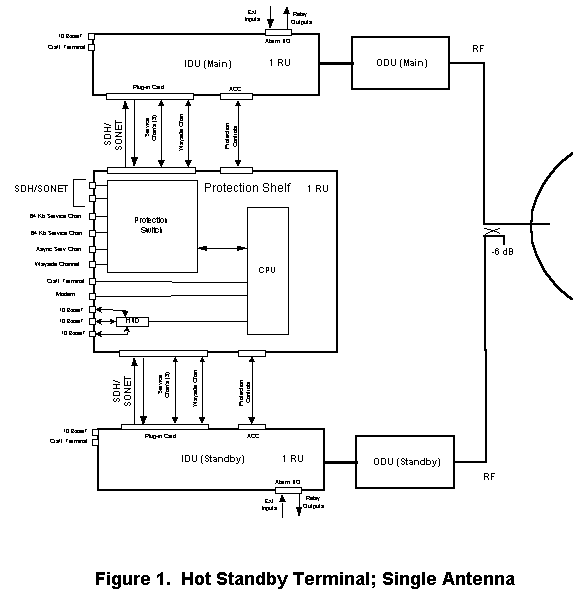SDH/SONET Microwave Backup Switch
Protection Switching
The basic protection switching arrangement is a hot-standby design operating as follows as shown in Figure 1.
One incoming 155 Mb signal (OC3 or STM-1) is divided to supply two high capacity IDU’s with 155 Mb each. These two transmit signals are applied to each of the two respective IDU’s which are powered up and on the same frequency. The protection switch will mute one of the two output transmitters so that only the on-line radio is transmitting a signal.
In the receive direction, two sets of 155 Mb signals are applied to the shelf by two high capacity IDU’s. Using switching logic, one of the receive signals is selected and applied to the traffic output port.
The two ODU’s are each connected to a separate antenna or, optionally, to a single antenna through a 6 dB coupler where the main path is routed through the direct coupler arm and the standby path is routed through the 6 dB coupled path. Switching logic will favor the main path but switching will not occur to bring a main radio on-line once its alarm has been cleared. Traffic will remain on the standby radio until changed in the manual mode or presence of a standby alarm with no main alarm. The standby radio stays on-line to avoid another outage just for radio switching. When there is an alarm on both receivers, (such as a rain fade), built-in delays will force the system to switch back so that the main radio is on-line and the standby radio is off-line.
The protection system is not errorless, but the downtime is held to a minimum since the switchover may occur in either the transmitter or the receiver. A receive switchover will cause an outage less than 50 milliseconds and a transmit switchover will cause an outage of less than 0.5 seconds.
Most user interfaces are made from a 1 RU height protection switching shelf that is connected to two standard IDU’s as shown in Figure 1. In addition to switching the SONET/SDH payload, the service channels, wayside channel and modem interface are switched. A 10BaseT hub is located in the protection shelf to allow for distribution to the two IDU’s.


